4.1 Learning Through Classical Conditioning
classical conditioning Acquiring a new response (the conditioned response) to a previously neutral stimulus (the conditioned stimulus) that reliably signals the arrival of an unconditioned stimulus.
Does the name “Pavlov” ring a bell? If you understand this really bad joke, then you are already somewhat familiar with classical conditioning—learning that one stimulus signals the arrival of another stimulus. A stimulus (plural: stimuli) is any sight, sound, smell, taste, or body sensation that a human or animal can perceive. You know from Chapter 1 that Pavlov’s dogs salivated to the sound of a tone (the first stimulus) because they learned to expect food in their mouth (the second stimulus) after hearing the tone. This may not sound like the research of a Nobel Prize–
The Elements and Procedures of Classical Conditioning
Ivan Pavlov was a Russian physiologist who won a Nobel Prize in 1904 for his earlier work on the physiology of digestion. Pavlov studied the digestive processes of dogs. During these experiments, the dogs were strapped into harnesses and had tubes inserted in their cheeks to measure salivation, the initial step in the digestive process. Pavlov had cleverly found a way to divert the saliva so that it was excreted through the dogs’ cheeks. As part of this research, the dogs were given food (meat powder), and then the amount of saliva excreted was measured. During this research, Pavlov made an accidental discovery. He noticed that the dogs started to salivate before the meat powder was even put in their mouths. For example, the dogs salivated when they heard the footsteps of his assistants bringing the meat powder. Pavlov wanted to know why, and this became the focus of his research for the remainder of his career. So what exactly did he do?
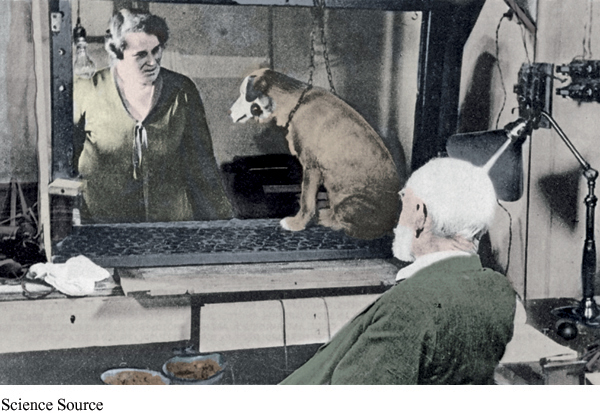
reflex A stimulus-
unconditioned stimulus (UCS) The stimulus in a reflex that automatically elicits an unconditioned response.
unconditioned response (UCR) The response in a reflex that is automatically elicited by the unconditioned stimulus.
Unconditioned stimulus (UCS) and unconditioned response (UCR). First, let’s consider why the dogs salivated when the meat powder was put in their mouths. This is a reflexive response—
Conditioned stimulus (CS) and conditioned response (CR). Pavlov began with a neutral stimulus, a stimulus that does not naturally elicit the to-
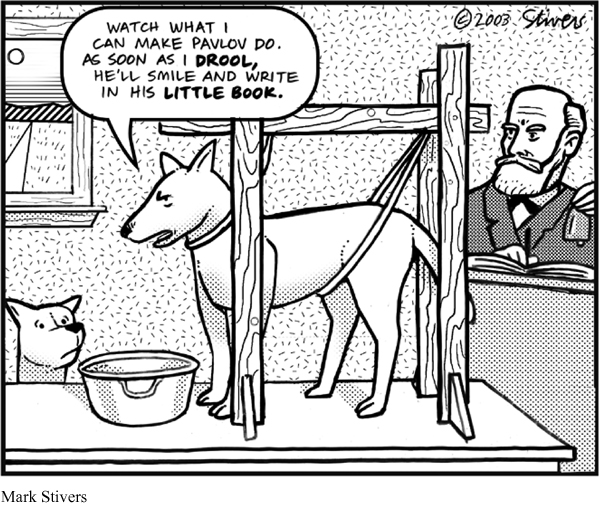
conditioned stimulus (CS) The stimulus that comes to elicit a new response (the conditioned response) in classical conditioning.
conditioned response (CR) The response that is elicited by the conditioned stimulus in classical conditioning.
Once the conditioning occurs (signaled in Pavlov’s research by the dog salivating to the sound of the tone before the meat powder is put into its mouth), the neutral stimulus is referred to as the conditioned stimulus (CS). This previously neutral stimulus (the tone) comes to elicit a new response (salivating) after repeated pairings with the unconditioned stimulus (meat powder in the dog’s mouth). The learned response (salivating) to the conditioned stimulus (the tone) is called the conditioned response (CR). The conditioned response (salivating) is a preparatory response for the impending UCS (meat powder in the dog’s mouth).
To firm up your understanding of the elements of classical conditioning, let’s consider another example, conditioning of the eyeblink response, which is often used in classical conditioning research with humans. A neutral stimulus, such as a tone, is presented just before a mild puff of air to a person’s eye (the UCS). Initially, an eyeblink (the UCR) occurs reflexively in response to the air puff (the UCS), but with repeated pairings of the tone followed shortly thereafter by the air puff, the previously neutral stimulus (the tone) becomes the conditioned stimulus (the CS) and now elicits a new response, an eyeblink (the CR), in advance of the air puff. In this case, the eyeblink serves as an adaptive, defensive response to the air puff. Instead of an air puff to a person’s eye as the UCS, Clark Hull, a major behavioral psychologist in the first half of the twentieth century, used a slap to the face as the UCS and his graduate students at Yale University as his subjects (Gluck, Mercado, & Myers, 2011). Thus, Hull trained his students to blink in anticipation of a slap to the face. For obvious ethical reasons, researchers have not followed in Hull’s footsteps and do not use the face slap as the UCS in human classical conditioning.
Delayed and trace conditioning. The timing of the relationship of the CS and UCS is a critical factor in classical conditioning. The conditioned stimulus (the tone) is presented just before the UCS (the meat powder in Pavlov’s experiments) because the conditioning involves learning that this stimulus is a reliable predictor for the arrival of the UCS (Rescorla, 1988). Thus, presenting the UCS before the CS (called backward conditioning) or presenting the UCS and CS at the same time (called simultaneous conditioning) typically leads to no conditioning or poor conditioning because the CS in these two cases would not be a good predictor of the UCS (Powell, Symbaluk, & MacDonald, 2002). The CS has to clearly predict the UCS by being presented first or conditioning usually will not occur. There are two ways to present the CS first: delayed and trace conditioning.
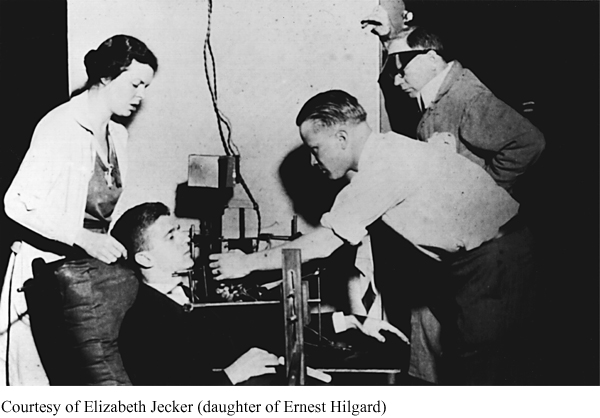
delayed conditioning A classical conditioning procedure in which the conditioned stimulus precedes the unconditioned stimulus and remains present until after the unconditioned stimulus is presented so that the two stimuli occur together.
trace conditioning A classical conditioning procedure in which the conditioned stimulus precedes the unconditioned stimulus but is removed before the unconditioned stimulus is presented so that the two stimuli do not occur together.
In delayed conditioning, the CS remains on until after the UCS is presented, so that the two stimuli occur at the same time. The tone would be turned on and not turned off until after the meat powder was placed in the dog’s mouth. This procedure is called “delayed” because turning off (taking away) the CS is delayed until after the UCS starts. In trace conditioning, there is a period of time between turning off the CS and the onset of the UCS (called the trace interval), when neither stimulus is present. In Pavlov’s case, this would mean turning the tone on and then off, waiting a brief period of time, and then putting the meat powder in the dog’s mouth. For the association between stimuli to be learned, the animal or human (dog in Pavlov’s case) must maintain a “memory trace” of the CS (the tone) to pair with the later-
Delayed conditioning is the most effective procedure for classical conditioning, but trace conditioning can be almost as effective if the trace interval between stimuli is very short (Powell, Symbaluk, & MacDonald, 2002). It also appears that for trace conditioning, processing by both the cerebellum and hippocampus is essential for successful conditioning whereas for delayed conditioning, only processing by the cerebellum is necessary (Clark & Squire, 1998). In trace conditioning, processing by the hippocampus is necessary to establish a memory trace of the CS so that it can be associated with the UCS following the trace interval (Bangasser, Waxler, Santollo, & Shors, 2006). In addition, it appears that delayed conditioning can be accomplished without conscious awareness of the temporal relationship between the CS and UCS, but trace conditioning cannot (Clark & Squire, 1998).
The entire classical conditioning process is diagrammed in Figure 4.1. Study the diagram to make sure you understand the four elements that are involved in classical conditioning—
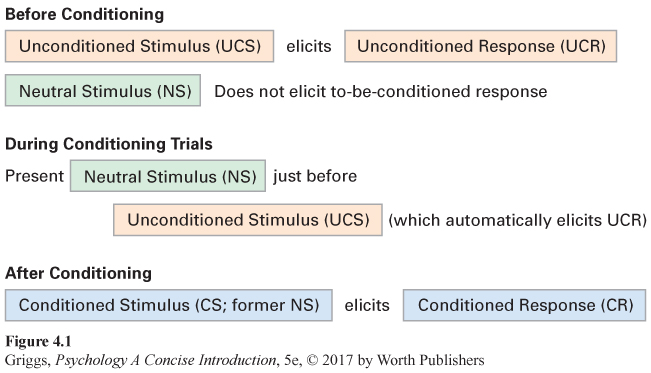
The Little Albert study. John Broadus Watson, an American psychologist in the early part of the twentieth century, was the founder of behavioral psychology (Watson, 1913, 1919). He was very impressed with classical conditioning and its potential use to make psychology an objective science of behavior. To examine the possible role of such conditioning in human emotional responses such as fear, Watson and his research assistant, Rosalie Rayner, conducted a fear-
Let’s think about the Little Albert study in terms of the four elements of classical conditioning—
You may be wondering what became of Albert and whether there were lasting effects of his fear-
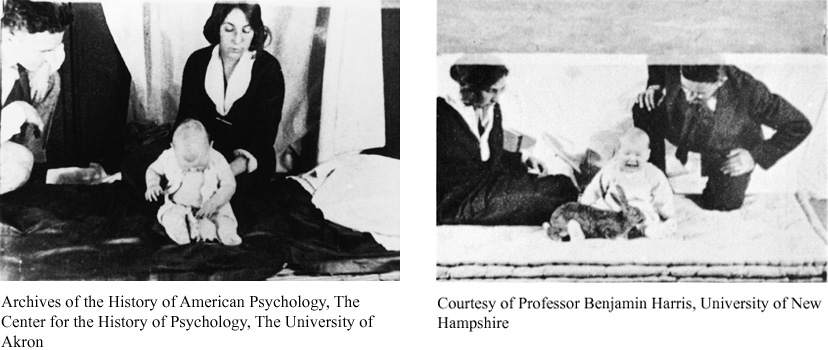
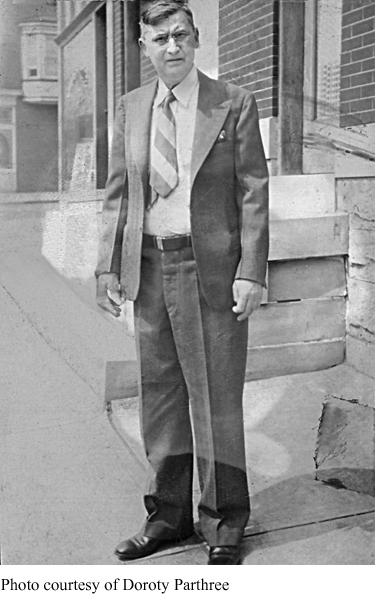
Although Watson and Rayner did not decondition Little Albert, one of Watson’s former students, Mary Cover Jones, demonstrated that such a fear could be deconditioned (Jones, 1924). She deconditioned a preexisting fear of rabbits in a 3-
It is important to realize that classical conditioning is not only involved in conditioning negative emotional responses such as fear, but can also be used to develop positive emotional responses to stimuli. For example, classical conditioning is used in advertising in order to condition positive attitudes and feelings toward products (Allen & Shimp, 1990; Grossman & Till, 1998; Olson & Fazio, 2001). Think about advertisements that pair celebrities with products. Pairing popular professional basketball players like Michael Jordan and LeBron James with Nike products in advertisements is a good example. Both of these athletes were paid millions of dollars for their Nike endorsements. Why? The advertisers attempt to use our positive feelings about these celebrities to condition positive responses to their products. The celebrity serves as the UCS, and the product as the CS. Advertising campaigns using this evaluative classical conditioning technique have proved very effective (Hofmann, De Houwer, Perugini, Baeyens, & Crombez, 2010). John Watson pioneered this type of advertising when he worked as a psychology consultant for the J. Walter Thompson advertising agency in New York following his dismissal from academics (Buckley, 1989). Watson was forced to leave the academic life after he had an extramarital affair with his research assistant on the Little Albert study, Rosalie Rayner.
General Learning Processes in Classical Conditioning
acquisition (in classical conditioning) Acquiring a new response (the conditioned response) to the conditioned stimulus.
We have seen how classical conditioning works: A new, learned response (the CR) is elicited by the CS in preparation for the arrival of the UCS. This response learning is also referred to as acquisition, acquiring a new response—
extinction (in classical conditioning) The diminishing of the conditioned response when the unconditioned stimulus no longer follows the conditioned stimulus.
Extinction and spontaneous recovery. What do you think would happen to the CR if the UCS no longer followed the CS? Would the CR now be “unlearned”? Remember that in classical conditioning the CS reliably signals that the UCS is coming. If the CS no longer serves this function, then the CR is no longer necessary so it is no longer made. No preparation is needed because the UCS is no longer presented. For example, in Pavlov’s work the dog would eventually stop salivating to the tone when the tone no longer signaled that the meat powder was coming. In the Little Albert study, Albert’s fear of a white rat would have diminished and eventually stopped over time if it no longer signaled that the loud, unexpected noise was coming, but remember, Watson and Rayner never did this. He left without being deconditioned. This unlearning or deconditioning process is called extinction, the diminishing of the CR when the UCS no longer follows the CS.
spontaneous recovery (in classical conditioning) A partial recovery in strength of the conditioned response following a break during extinction training.
A visual comparison of the acquisition and extinction processes is given in Figure 4.2 (a and b). The strength of the CR increases during acquisition, but it decreases during extinction. Note, however, that during the extinction process, the CR mysteriously increases somewhat in strength following a rest interval. This is called spontaneous recovery, a partial recovery in strength of the CR following a break during extinction trials (see Figure 4.2c). As extinction continues, however, the recovery observed following the rest intervals continues to decrease until it is minimized. For example, the dog would salivate very little or not at all to the tone. The spontaneous recovery that occurs during the extinction process indicates, as Pavlov had concluded, that the CR may not be totally lost during extinction, but only greatly weakened or inhibited. Research since Pavlov’s time has demonstrated that this is indeed the case (Bouton, 1994; Rescorla, 1996).
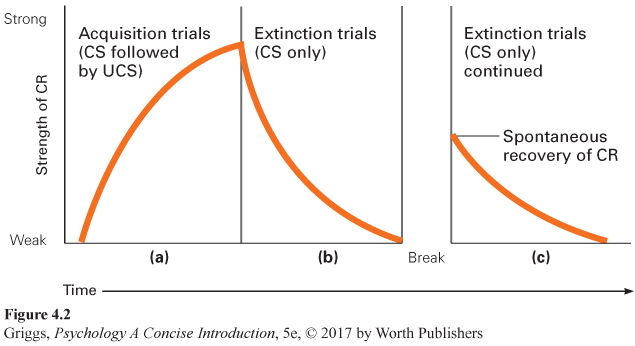
stimulus generalization (in classical conditioning) The elicitation of the conditioned response to stimuli that are similar to the conditioned stimulus. The more similar the stimulus is to the conditioned stimulus, the stronger the response.
Stimulus generalization and discrimination. In addition to acquisition, extinction, and spontaneous recovery, there are two other general learning processes involving the CR—
To understand generalization, let’s consider Pavlov’s research with dogs. Assume Pavlov classically conditioned a dog to give the salivary response to a tone with a pitch of 1,000 Hz. (Remember from Chapter 3 that this represents a sound wave that cycles 1,000 times per second.) To test for generalization, the CS (the 1,000 Hz tone) and the other stimuli (tones with higher and lower frequencies) are presented, but the UCS (the meat powder) does not follow any of them. The strength of the CR (the amount of salivation) to each of these stimuli is measured. So what would happen if a 1,025 Hz or a 975 Hz tone were presented? The dog would probably give a fairly strong salivary response to these tones because they are very similar to the original CS of 1,000 Hz. But the strength of the CR (the amount of salivation) would go down as the generalization test tones get farther away from the original CS of 1,000 Hz. This generalization function is illustrated in Figure 4.3. Ignore the discrimination function in the figure for now. We will discuss it shortly.
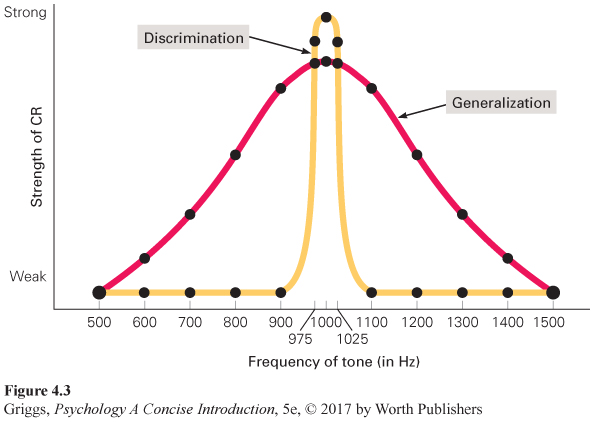
Notice how symmetric the generalization test results are around the original CS value (1,000 Hz) in Figure 4.3. This is because the generalization test tones could be varied symmetrically in frequency above and below the original CS tone. But think about the Little Albert study by Watson and Rayner. Their original CS was a white rat so the generalization stimuli could not be varied symmetrically around it. What do you think they used to test for generalization? The main objects that they used were other animals—
stimulus discrimination (in classical conditioning) The elicitation of the conditioned response only by the conditioned stimulus or only by a small set of highly similar stimuli that includes the conditioned stimulus.
Sometimes we overgeneralize and need to narrow our responding to a specific stimulus or smaller set of stimuli. In the case of the dog bite, we might overgeneralize and fear any dog. This wouldn’t be rational, so we would need to learn to discriminate dogs that might bite us from those that would not. Such discrimination learning can be thought of as the opposite of generalization. Generalization leads to the CR being given to a broader set of stimuli; discrimination leads to the CR being given to a narrower set of stimuli. In classical conditioning, stimulus discrimination is the elicitation of the CR only by the CS or only by a small set of highly similar stimuli that includes the CS. In the dog bite example, this would be learning only to fear potentially dangerous dogs.
Discrimination training is used to teach stimulus discrimination. We will discuss the simplest case—
Idealized results of stimulus discrimination training for a CS tone of 1,000 Hz in our Pavlovian classical conditioning example are shown in Figure 4.3. As you can see, responding is centered at 1,000 Hz, as it is for the stimulus generalization results. However, unlike the generalization results, the responding following discrimination training is to a much narrower range of stimulus frequencies. The animal has learned only to salivate to the 1,000 Hz tone and tones very similar to it (975 Hz and 1,025 Hz). Why does the animal salivate at all to any stimulus other than the 1,000 Hz tone? It wouldn’t if it had perfect pitch perception and could discriminate all frequencies, but it can’t. Thus, the animal salivates to this narrow range of frequencies because it has difficulty differentiating them. This is why discrimination training can be used to learn what nonverbal animals (and human infants) can discriminate. If they respond to stimuli the same way, then it is assumed that they cannot differentiate between the stimuli.
All five of the general learning processes for classical conditioning are summarized in Table 4.1. If any of these processes are not clear to you, restudy the discussions of those processes in the text and their visual depictions in Figures 4.2 and 4.3 to solidify your understanding. You want to ensure that you understand these learning processes for classical conditioning, because they will be redefined for operant conditioning in the next section.
| Learning Process | Explanation of Process |
|---|---|
| Acquisition | Acquiring a new response (the conditioned response) to the conditioned stimulus |
| Extinction | Diminishing of the conditioned response when the unconditioned stimulus no longer follows the conditioned stimulus |
| Spontaneous recovery | Partial recovery in strength of the conditioned response following a break during extinction training |
| Stimulus discrimination | Elicitation of the conditioned response by stimuli that are similar to the conditioned stimulus (the more similar, the stronger the response) |
| Stimulus generalization | Elicitation of the conditioned response only by the conditioned stimulus or only by a small set of highly similar stimuli that includes the conditioned stimulus |
Section Summary
In this section, we discovered that one way we learn about the world is by noting associations between various stimuli in our environment. This is called classical conditioning. Classical conditioning occurs when a conditioned stimulus (CS) reliably predicts the arrival of an unconditioned stimulus (UCS), which reflexively elicits an unconditioned response (UCR). In Pavlov’s research, for example, a tone (CS) predicted the arrival of meat powder (UCS) that automatically elicited a salivary response (UCR). The optimal way to pair the two stimuli together in classical conditioning is called delayed conditioning. The CS is presented shortly before the UCS, but the CS continues so that the two stimuli occur together (the tone is turned on and left on until the meat powder is put in the dog’s mouth). The learning is the acquisition of a new response, the conditioned response (CR) to the CS (the dog starts salivating to the sound of the tone).
Once this new response is acquired, it will be generalized to stimuli similar to the CS (tones similar in frequency to the particular tone used as the CS in conditioning). Although this generalization of the CR is an adaptive process, we can learn to discriminate the CS (the particular tone used in conditioning) from other stimuli (tones) except those highly similar to the CS. In discrimination learning, we learn that the CS is the only stimulus that is followed by the UCS. When the UCS no longer follows a stimulus, the CR (salivation) is extinguished (no longer given). However, the CR temporarily increases in strength following breaks during the extinction process. This is known as spontaneous recovery and indicates that the CR may still be available in a weakened or inhibited form.
1
Question 4.1
.
At about the same time that Pavlov accidentally discovered classical conditioning and began studying it, an American graduate student at the University of Pennsylvania, Edwin Twitmyer, was conducting his doctoral research (see Twitmyer, 1974). Twitmyer was examining the strength of the knee-
The UCS was the hammer striking the participant’s knee, and the UCR was the participant’s knee jerk in response to the hammer strike. The CS was the bell ringing, and the CR was the participant’s knee jerk in response to this bell.
Question 4.2
.
Explain why Watson and Rayner’s Little Albert study is an example of the delayed conditioning procedure, not the trace conditioning procedure.
The Little Albert study is an example of using the delayed classical conditioning procedure because the CS (the white rat) was presented before the UCS (the loud, unexpected noise) and remained there until the UCS was presented. If the white rat had been taken away before the unexpected loud noise, then the study would have been an example of using the trace conditioning procedure.
Question 4.3
.
Explain why generalization and discrimination can be thought of as opposites.
Generalization and discrimination can be thought of as opposites because generalization is the broadening of the conditioned response to other stimuli, whereas discrimination is the narrowing of the response to only the stimulus followed by the UCS and those stimuli so similar to this stimulus that they cannot be discriminated from it.
Question 4.4
.
Explain which other general learning process is used in discrimination training.
Extinction is used during discrimination training. The responses to all stimuli except the original CS are diminished because the UCS does not follow any of them. However, if a stimulus cannot be discriminated from the CS, the response to it is not extinguished.